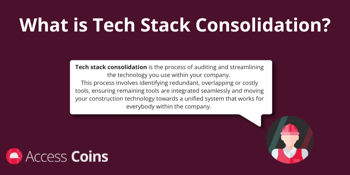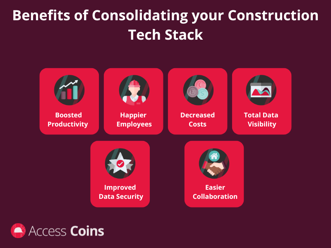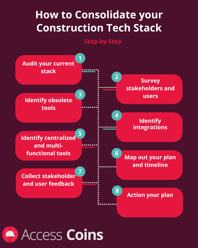Tech Stack Consolidation in Construction – a Step-by-Step Guide to making Construction Technology Work for your Business
In the era of digital transformation in construction, many US construction companies have adapted a wide range of technologies and software solutions to help adapt to and solve the many issues facing the construction industry, from digitizing billing and invoicing to making construction more sustainable.
While cloud software and mobile apps have helped construction businesses streamline their processes across the project lifecycle, they have also introduced a whole new set of problems for construction operations.
An overloaded tech stack, handling different sets of data that struggle to integrate, can lead to miscommunication, incorrect data, and delays in delivery.
In this article, we review what issues an overloaded tech stack can bring to the construction process, how tech stack consolidation can help, what solutions are available, and a step-by-step guide to consolidating your construction ‘frankenstack’!
Contents
- What is a Tech Stack in Construction?
- Issues Created by the ‘Frankenstack’ in Construction
- What is Tech Stack Consolidation?
- What are the Benefits of Consolidating your Construction Tech Stack?
- What to Consider when Consolidating your Construction Tech Stack
- How to Consolidate your Tech Stack – Step-by-Step
What is a Tech Stack in Construction?
A tech stack in construction is a construction company’s collection, or ‘stack’ of digital apps, SaaS tools and other technologies that employees across departments use in their roles.
This covers everything from construction accounting software to communication platforms to equipment trackers.
A 2021 survey of IT managers in the US found that companies average over 200 pieces of software – and that number will have only grown.
The unique, project-based, nature of construction can lead to a bigger stack than most. As software is quickly deployed to resolve issues or meet requirements outlined in projects, software is adapted, used throughout a project, then abandoned (or even worse, abandoned by some while still being used by others).
Construction is also vulnerable to the ‘frankenstack’ as contractors have multiple facets to their business. Accounting, payroll, equipment, new projects, servicing and maintenance may end up running on disconnected solutions which fail to talk to each other.
These solutions, many with a singular function or purpose, can quickly stack up. Workers on the field and those in office roles may be using different solutions, with the disconnect leading to silos and miscommunications.
The result? An overloaded digital workplace, confusion and frustration.
Issues Created by the ‘Frankenstack’ in Construction
The act of purchasing more and more solutions to resolve arising issues, fill gaps and address growing needs within a business is known as ‘Frankensteining’, and ‘Frankensteining’ leads to the ‘Frankenstack’ – a collection of disconnected solutions and systems used to manage your delivery.
While the original purpose of turning to digital transformation is to make delivery easier and more efficient, using a huge range of solutions leads to a domino-effect where ‘solutions’ can generate further problems down the line.
The ‘Frankenstack’ leads to multiple issues within construction companies.
Increased Time and Money Spent Managing Multiple IT Solutions
Every solution demands time around implementation, training, maintenance, vendor management and support. The more solutions, the more IT resource is needed to ensure every solution is embedded, being used correctly and delivering on ROI.
Alongside the increased costs of IT management and support, the cost of the solutions themselves will rise as more are added to the towering stack.
Integration Blocks
In a perfect world, all of your solutions would work from the same set of data and integrate seamlessly. Unfortunately, this is rarely the case. While your financial management solution may integrate with your HR solution, maybe it cannot integrate with the tool you purchased to handle construction payroll, or the solution you implemented for service technicians to generate invoices.
Inconsistent and disconnected data and a lack of ‘single source of truth’ makes construction and service operations increasingly difficult.
Decreased Productivity
An overloaded tech stack can lead to employees spending more of their time managing their digital solutions instead of delivering the work they are paid to do.
Switching from interface to interface, manually transferring data from one solution to another, struggling to find information in one solution which is in fact stored on another and updating colleagues who use another system are just a few examples of how a ‘frankenstack’ can be a major productivity suck within a construction company.
Security Vulnerabilities
Sensitive data is handled across every step of the construction lifecycle. Multiple solutions involve multiple sets of data, stored in different clouds (or even stored on-premises), often with few or no access controls applied.
The more data is shared between applications and stored in different places, the more vulnerable the data is to cyberattacks or data loss. This applies to internal, external and, most importantly, client data.
Decreased Employee Engagement
Office-based employees can easily grow frustrated and bored with ever-changing and increasing solutions. That frustration can lead to an increase in employee resistance to technology, leading to a refusal to use the solutions that have become mission-critical and even a risk of losing employees who have grown tired of managing their own ‘Frankenstack’.
Employees can also feel overwhelmed not just with the amount of applications, but the amount of information they receive hour-to-hour. This can lead to workers missing vital information and updates across the constantly updating feeds they have across multiple applications.
This situation can get even worse with those working on job sites. Those in the field have a limited amount of time available to engage with technology and can get understandably frustrated with the growing demands on them to input data and manage multiple field apps.
With the construction labor shortage growing ever-larger, construction companies cannot afford to lose skilled field workers and technicians due to a poorly-managed technology stack.
Thankfully, there is a way to defeat the Frankenstack – tech stack consolidation.
Access Coins is a Centralized Solution Built for Construction
Access Coins ERP covers countless business functions under one system – all built for the specifics of the construction industry.
What is Tech Stack Consolidation?
Tech stack consolidation is the process of auditing and streamlining the technology you adapt within your company.
This process involves identifying redundant, overlapping or costly tools, ensuring remaining tools are integrated seamlessly and moving your construction technology towards a unified system that works for everybody within the company.

What are the Benefits of Consolidating your Construction Tech Stack?
Consolidating and simplifying your tech stack can be a time-consuming process in itself, but the rewards are multiple. A well-managed tech stack consolidation process should lead to:
- Reduced costs
- Increased efficiency through using a standardized tool set
- Decreased data silos and the security vulnerabilities and errors that come with them
- A much more rewarding connected experience for employees in the office and on the field
- Better quality data and true visibility of data, leading to better insights and decision-making across the business
Reduced Costs
This may seem like an obvious benefit, but it will be the one your stakeholders are most interested in! Consolidating your tech stack should reduce the number of licenses and subscriptions needed, alongside reducing costs and time linked to maintenance.
Increased Efficiencies
Fewer, connected systems should lead to a more collaborative, efficient and productive workplace.
Improved Data Management
One of the biggest benefits of consolidating your tech stack is working towards every team member working from the same, connected set of data. This will greatly improve your insights, budgeting and forecasting at every level of your construction business.
Improved Data Security
Reducing the amount of systems on which you host sensitive data will reduce the points of vulnerability for potential cyberattacks, data breaches or lost data.
Better User Experience
Employees working on a connected and centralized tech stack will have a better experience and higher job satisfaction.

What to Consider when Consolidating your Construction Tech Stack
Construction companies face unique vulnerabilities that come with tech overload and consolidation. To effectively consolidate construction technology, it's crucial to understand these challenges.
These considerations will help guide the development of a streamlined digital workplace that addresses specific needs and solves critical problems.
Compliance
Construction is a highly regulated industry, from building codes to sustainability laws. These regulations are also regularly reviewed and updated and apply across many levels, whether national, state or city. Construction companies must ensure their chosen technology is compliant to any regulations, or includes functionality which takes these regulations into consideration.
Employee and Department Needs
Construction technology must meet a huge range of needs across the different teams who work across a project. The most obvious divide is between those who work on and off-site. Those in the field will appreciate technology which is remote, easy-to-use and saves them time to focus on physical work or supervision. Employees who work off-site will be more used to using technology day-to-day, but will appreciate visibility of data and ease of finding information above all.
Those who divide their time between the field and the office, such as project managers and architects, will be looking for technology which is connected and integrated, so they can work easily in both environments and don’t face technology blocks when working across departments.
Explore our field service management software to see how technology boost collaboration by linking the field to the office.
Risk Management
The construction industry is no stranger to risk, and just like every project needs thorough risk management, so does your tech stack consolidation.
While better risk management in construction is one of the many benefits of consolidating your tech stack, potential risks also need to be considered when planning your new technology workflows. This includes planning for data migrations and integrations, ensuring there is some overlap during a ‘handover’ from one piece of technology to another and planning for data breaches.
Multi-Functional Tools
A popular tech stack consolidation strategy is to implement tools and technologies that cover multiple functions. The fewer tools and systems your team and employees have to handle, the better your technology workflow will function.
While there is a risk in relying on a single tool to perform many business-critical functions, an ‘all-in-one’ approach will achieve better results in terms of productivity, cost and scalability.
A ‘Single Source of Truth’ for your Data
Replacing multiple solutions with a single platform will also help your team achieve a ‘Single Source of Truth’ for your data. This is when siloed data is minimized and every team across the project lifecycle – from initial tender to project maintenance – are working from a single, accurate set of data.
For example, a service management solution that creates invoices and tracks hours may be disconnected from your PO and payroll solutions which can show different numbers and logged hours.
Having a single source of truth for your construction data helps with visibility, project efficiency and, crucially, project certainty.
Access Coins Provides a Single Source of Truth
Access Coins ERP covers countless business functions under one system – all built for the specifics of the construction industry.
How to Consolidate your Tech Stack – Step-by-Step
While your exact process will depend on the size, complexity and needs of your company, these are the steps you will need to take to consolidate your current ‘frankenstack’ and build a construction tech stack that works for every member of your team.

Outline and Communicate your Tech Stack Consolidation Process
First of all, make sure your team knows about the project. Outline your top-line plan, the reasons why you are consolidating your tech and the outcomes you want to achieve. Ensure that all major stakeholders within your company are aware of the project and communicate how tech stack consolidation will help with business goals and improve technology ROI.
Audit your Current Construction Tech Stack
Start building a comprehensive list and review of every piece of technology which is currently used within your company. Identify –
- Cost
- ROI
- Core functionalities
- Users
- How often the technology is used
- Integration capabilities
- User satisfaction (this may be easier to identify after the next step)
You should then be able to categorize your tech stack, mapping out which technologies are used by which teams.
Once you have built this audit, it will be easier to identify obsolete tools, overlapping functionalities and your first opportunities for consolidation.
Survey Stakeholders and Employees to Identify Needs and Challenges
The most important data you need to successfully consolidate your tech stack is the views of those who are actually using the technology.
Once you have completed your audit, put together surveys for both stakeholders and employees who use your technology. There are endless approaches to this, but the aim is to get an idea of how your current stack is working, what the core frustrations are around your current technology, what works and what doesn’t.
You may want to ask users to score the systems they use on a scale of 1-10 to get a good gauge of overall user satisfaction.
This will also help you identify both ‘mission critical’ technology which is used every day across departments and the tools which are gathering virtual dust.
Identify Redundant and Disconnected Tools
Now you have your audit and survey data, it’s time to identify those tools which can easily be removed without causing operational issues. This is an opportunity to clear out any obsolete tools which are still being paid for to immediately cut the cost of your tech stack.
Identify Possible Integrations
At this point, it will be useful to turn your audit/checklist into a map and look at the technology workflows and processes within and between each department within your company.
Understanding which tools ‘speak’ to each other through integrations and which tools are disconnected is the basis from which you can build a more connected tech stack which uses the same data.
It is particularly important to identify which integrations are mission-critical, for example financial management and payroll.
It may be the case that there are integrations available which you weren’t aware of – review disconnects between your tools and see which integrations are available. It is best to check independent reviews to see how well these integrations work.
Research and Build a Business Case for Centralized Tools
While the aim of your tech stack consolidation process is to reduce the amount of tools you use, it will be useful to research investing in new tools which can replace multiple systems in one go. Centralized and cross-functional tools such as construction ERP not only cover multiple functions, but also provide that all-important ‘single source of truth’ for your data.
Review what is on offer and build a business case for key stakeholders to review for your chosen solutions.
Read more on how to Build a Business Case for Construction ERP.
Map Your Tech Stack Consolidation Plan and Timeline
Now it’s time to truly get stuck in and map out your new, connected tech stack and set out your deadlines for how to get there.
At this point you should have a clear view on what to keep, what to phase out, what needs to be conencted and which, if any, new technology needs to be implemented and onboarded.
Set out a clear timeline for your consolidation plan, including clear dates for tools going offline, online, integrations going live, data migrations and training periods for any new systems. Assign responsibilities across your wider team.
Gain Stakeholder and Employee Feedback on your Tech Stack Consolidation Plan
Now it’s time to once again survey your stakeholders and users around your tech stack consolidation plan before starting the work. It is essential to gain buy-in from both key figures in the business and those who will be using the technology every day.
While it is likely not everyone will be completely happy, it is important to collect this feedback to see if your plan may cause any major disruptions or knock out any tools which are deemed business-critical to stakeholders.
Once you have collected feedback, be open to making adjustments to your plan to ensure company-wide buy-in and a smooth transition to your new tech stack.
Action Your Tech Stack Consolidation Plan
Finally, you can put your plan into action!
Most will begin with phasing out redundant tools and beginning plans around integrations, which may take some time.
Keep a record of every action you make and ensure you are communicating your actions regularly to both stakeholders and the wider team to avoid any unpleasant surprises.
Tech consolidation plans are often phased to ensure that no workers are left facing frustrations around their technology being lost or not transitioned correctly. Communication is essential during this phase to help minimize disruption.
Plan for Further Reviews of your New Tech Stack’s Performance
Your work isn’t over yet! Tech stack consolidation is an ongoing process, and your tech stack will need to be maintained and regularly reviewed and optimized.
Create and implement a review process across your company to ensure your new integrated tech stack is working to make everyone’s lives easier and, essentially, still contributing towards your businesses’ overall goals.
How Access Coins ERP can Help you Defeat the ‘Frankenstack’
Access Coins is a leading ERP platform that is built specifically for the construction industry. Built around a powerful financial management and construction accounting module, Access Coins is designed to provide a single source of truth for your data, across every step of the construction lifecycle.
Access Coins ERP provides leading construction businesses and MEP contractors with:
- Powerful data analytics and real-time dashboards
- A huge range of functionalities from construction payroll to equipment management
- Seamless integrations across modules for total data visibility and control
- Remote apps built for MEP contractors to link the field to the office

 UK
UK
 AU & NZ
AU & NZ
 SG
SG
 MY
MY
 IE
IE




